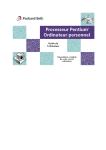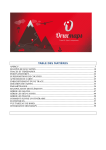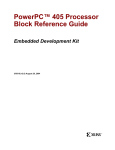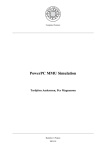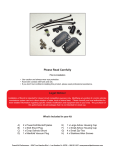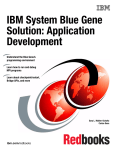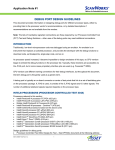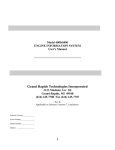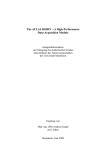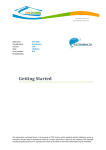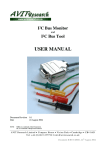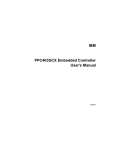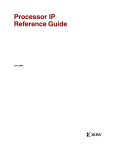Download Errata - Xilinx
Transcript
Errata
Xilinx
This document contains errata and design notes that
affect designs using the PPC405D5X1,
PPC405D5X2 and PPC405F6X1. Each erratum
includes an overview, a description of the system
impact and a description of possible work-around(s).
Design notes cover items that are not considered
errata but need a description beyond what is
provided in published documentation. Table 1 identifies errata affecting cores by version. Tables 2 and 3
contain a summary of all errata and design notes.
Items are listed in numeric order. Gaps in the
numeric sequence are intentional; only applicable
items are included in this document.
Category definitions:
Errata are classified according to system impact and
availability of a work-around.
1. Major impact, no workaround is available. A
problem is said to have a major impact if it
results in a system crash, a hard failure, an
PPC405_core_5_2_0.fm.5.2.0
April 8, 2004
unrecoverable soft failure, significant performance degradation, or the storage of incorrect
data.
2. Major impact, workaround is impractical to
implement, or a substantial risk of encountering
the same or additional problems, including performance issues, exist after the workaround is
implemented.
3. Major impact, workaround available. Application
of the workaround either eliminates the problem,
or reduces it to a minor impact issue.
4. Minor impact, no workaround is available. Minor
impact problems result in slight to moderate performance degradation, or are a functional variance from specification.
5. Minor impact, workaround is available. Minor
impact problems result in slight to moderate performance degradation, or are a functional variance from specification.
6. Design enhancement.
Page 1
Errata
Xilinx
Errata Summary
Table 1. List of all errata and core(s) affected
Issues
PPC405D5X1 PPC405D5X2 PPC405F6X1
CPU_121
X
X
X
CPU_147
X
X
X
CPU_153
X
X
X
CPU_162
X
X
X
CPU_163
X
X
X
CPU_187
X
X
X
CPU_197
X
X
X
CPU_208
X
X
X
CPU_210
X
CPU_211
X
X
CPU_212
X
X
CPU_213
X
X
X
Table 2. Errata Summary
Date First
Documented
Date Last
Updated
The iccci instruction may errantly cause a Data TLB Exception.
4/19/99
4/19/99
3
Virtual memory marked as non-executable storage (storage attribute EX=0) can
be loaded into the instruction cache using the icbt instruction.
8/12/99
4/27/00
CPU_153
5
Floating point enabled exceptions do not update CR1 field of the CR.
9/13/99
4/26/00
CPU_162
3
When in real mode, the 405 core may errantly make speculative instruction
fetches from guarded storage.
1/7/00
2/24/00
CPU_163
3
Floating point enabled exception handlers cannot reliable determine if SRR0
points to the excepting instruction.
1/17/00
4/26/00
CPU_187
3
Access to guard storage via APU load/store double-word or APU load/store
quad-word instructions is not architecturally compliant.
4/12/00
5/10/00
CPU_197
3
Incorrect real mode attributes may be used when accessing the last instruction in
a 128 MB region.
11/17/00
11/17/00
CPU_208
3
icbt instructions executed with data relocation enabled may cause incorrect
instruction execution if the icbt misses in the UTLB or does not have permission
to access the page.
8/21/01
8/21/01
CPU_210
2
Interrupted stwcx. instructions may errantly write data to memory under certain
DCU conditions.
8/30/01
8/30/01
Item
Category
CPU_121
3
CPU_147
Page 2
Description
PPC405_core_5_2_0.fm.5.2.0
April 8, 2004
Errata
Xilinx
Table 2. Errata Summary
Item
Category
CPU_211
3
Description
When deterministic multiplication is enabled (Core Input
TIEC405DETERMINISTICMULT = 1), the mulhw[.],mullw[o][.] and mulli instructions
Date First
Documented
Date Last
Updated
6/26/02
6/26/02
may generate wrong result.
CPU_212
3
When attached to a multi-cycle OCM controller, the PPC405 core may assert the
C405_dsocmWait signal during the assertion of DSOCM_c405Hold or
DSOCM_c405Complete for an OCM store operation. The PPC405 will ignore a
valid DSOCM_c405Complete signal for an OCM store while asserting
C405_dsocmWait.
9/27/02
10/18/02
CPU_213
3
Incorrect data may be flushed from the data cache.
2/21/03
5/7/03
PPC405_core_5_2_0.fm.5.2.0
April 8, 2004
Page 3
Errata
Xilinx
Design Note Summary
Table 3. Design Summary
Item
Description
Date First
Documented
Date Last
Updated
There are no Design Notes for the PPC405D5X1, PPC405D5X2 or
PPC405F6X1.
Page 4
PPC405_core_5_2_0.fm.5.2.0
April 8, 2004
Errata
Xilinx
CPU_121
The iccci instruction may errantly cause a Data TLB Exception.
Category: 3
Overview:
When data-side relocation (data address translation) is enabled (MSR[DR] = 1), an iccci instruction errantly
attempts an access check for the associated page. Since iccci invalidates the entire instruction cache, the
effective address it generates is unnecessary.
Impact:
When data-side relocation (data address translation) is enabled, the execution of an iccci may cause a Data
TLB miss exception.
Work-around:
There are two possible work-arounds. Work-around 1 avoids this erratum by temporarily disabling data
address translation. Work-around 2 describes how to handle this erratum without disabling data address
translation.
1. Before executing an iccci instruction, make sure the MSR[DR] is disabled. This can be done using
the following pseudo code:
mfmsr
andi
mtmsr
isync
iccci
mtmsr
isync
Rx
Ry,Rx,DR_MASK
Ry
! Rx is a scratch reg
! clear MSR[DR] in scratch reg Rx
0,Rx
Rx
! The address does not matter.
2. When data-side relocation is enabled, ensure that the virtual address generated by the iccci (virtual
address = {PID, effective address (RA | 0 + RB)}) has a corresponding page in the TLB.
PPC405_core_5_2_0.fm.5.2.0
April 8, 2004
Page 5
Errata
Xilinx
CPU_147
Virtual memory marked as non-executable storage (storage attribute
EX=0) can be loaded into the instruction cache using the icbt instruction.
Category: 3
Overview:
The icbt instruction should execute as a nop (no operation) when the effective address corresponds to a
memory page marked as non-executable. Instead, an instruction cache line fill occurs when the effective
address of the icbt instruction maps to memory region having the following three characteristics:
1. Marked as non-executable storage (storage attribute EX = 0).
2. Marked as cacheable (storage attribute I = 0).
3. Access is not prohibited by a zone fault (The access control field ZSEL references a ZPR field that
does not prohibit access).
Impact:
Touching data belonging to a page marked as non-executable storage into the instruction cache with the icbt
instruction can result in unnecessary memory accesses. Note that:
1. Memory marked as non-executable (EX = 0) cannot be executed even if loaded into the instruction
cache.
2. icbt instructions are not compiler generated; they are isolated to assembly routines.
Work-around:
1. No work-around is necessary if either:
a. The translation from virtual to real does not change.
b. There are no occurrences where an icbt instruction causes a cache line fill of data from a page
marked as non-executable storage.
2. Invalidate cache blocks (lines) loaded with data belonging to a page marked as non-executable storage. Use either an icbi or an iccci instruction.
Page 6
PPC405_core_5_2_0.fm.5.2.0
April 8, 2004
Errata
Xilinx
CPU_153
Floating point enabled exceptions do not update CR1 field of the CR.
Category: 5
Overview:
Floating Point Enabled Exceptions (excluding Enabled Invalid Operation and Enabled Zero Divide Exceptions), that occur on floating point instructions with the RC bit set, architecturally should update the CR1 field
of the CR, but do not.
Impact:
CR1 of the CR cannot be relied upon by the floating point enabled exception handler to describe the
excepting floating point operation.
Workaround:
1. None is required if a or b is true:
a. The floating point enabled exception handler is not used
b. The FPSCR, not the CR1, is used by the exception handler.
2. If the floating point enabled exception handler is used, the interrupt handler must examine the instruction
pointed to by SRR0 to determine if a CR update is needed and if so which CR field.
PPC405_core_5_2_0.fm.5.2.0
April 8, 2004
Page 7
Errata
Xilinx
CPU_162
When in real mode, the 405 core may errantly make speculative instruction fetches from guarded storage.
Category: 3
Overview:
In real mode, if instructions (guarded storage or not) and memory mapped I/O (guarded storage) are within
1KB of each other, it is possible for the I/O to be speculatively accessed when the instructions are executed.
Impact:
Memory mapped I/O (MMIO) may be speculatively accessed. An unintentional access to MMIO could result
in a loss of data.
Workaround:
Maintain at least 1KB of separation between instructions and memory mapped I/O.
Page 8
PPC405_core_5_2_0.fm.5.2.0
April 8, 2004
Errata
Xilinx
CPU_163
Floating point enabled exception handlers cannot reliable determine if
SRR0 points to the excepting instruction.
Category: 3
Overview:
When a floating point enabled exception exists while the MSR[FE0] and MSR[FE1] bits are off and either or
both of the MSR[FE] bits are re-enabled via a mtmsr, rfi, or rfci instruction, the floating point enabled exception handler has no way of determining whether the exception was caused by the instruction pointed to by
SRR0 or some earlier instruction.
Impact:
Floating point enabled exception handlers cannot reliable determine if SRR0 points to the excepting instruction.
Workaround:
1. None required if floating point enabled exceptions are not enabled via the FPSCR.
2. Perform a and b:
a. Ensure no floating point instructions immediately follow a mtmsr that turns on either of the MSR[FE]
bits. Architecturally an isync instruction should always follow a mtmsr.
b. Before executing rfi or rfci instructions that re-enable the MSR[FE] bits ensure that there are no outstanding floating point enabled exceptions. Interrupt handlers that have no floating point instructions
should not need to check the FPSCR.
PPC405_core_5_2_0.fm.5.2.0
April 8, 2004
Page 9
Errata
Xilinx
CPU_187
Access to guard storage via APU load/store double-word or APU
load/store quad-word instructions is not architecturally compliant.
Category: 5
Overview:
Architecturally a data aligned load or store (not including multiples or strings) to storage marked as guarded
should not be accessed speculatively. The 405 core breaks double and quad-word operations into 2 and 4
word transfers respectively. As an example, consider aligned double-word transfers to guarded storage.
Once the first word of a double-word transfer has reached load write-back (LWB) it is uninterruptible. If the
second piece is still in execute (EXE) or in write-back (WB) pipeline stage, it may be interrupted due to an
asynchronous interrupt. When the interrupt handler returns to the interrupted load double-word, the instruction is restarted from the beginning causing the guarded storage location accessed by the first piece of the
load double word to be accessed a second time. Similarly, for double-word store instructions that are interrupted immediately after the first piece of data has left the write-back stage, returning from the interrupt
handler will restart the instruction causing the first piece to be accessed from the guarded location twice.
If the APU load/store double-word or APU load/store quad-word involves 32-bit or smaller RT or RS registers
such that the double or quad-word transfer resembles a load/store multiple, then the guarded requirement
does not apply. If the APU load/store double-word or APU load/store quad-word involves 64 or 128-bit registers respectively, then the guarded requirement does apply and accessing the guarded location twice is not
architecturally compliant. Currently this is a problem for floating point load/store double-word operations to
guarded storage.
Impact:
APU load/store double-word or APU load/store quad-word operations to 64-bit or 128-bit registers respectively that have a data-side effective address to guarded storage may access the guarded storage twice in
presence of asynchronous interrupts.
Workaround:
Do not issue APU/FPU double or quad word storage instructions to guarded storage.
Page 10
PPC405_core_5_2_0.fm.5.2.0
April 8, 2004
Errata
Xilinx
CPU_197
Incorrect real mode attributes may be used when accessing the last
instruction in a 128 MB region.
Category: 3
Overview:
When executing instructions in real mode (MSR[IR] = 0), an access to the last instruction in a 128 MB region
uses the real mode attributes of the next consecutive 128 MB region under any of the following conditions:
1. The last instruction in a 128 MB region contains a branch target that is non-cacheable or causes a
cache miss.
2. The address restored by an rfi or rfci is the last instruction in a 128 MB region and this address is
non-cacheable or causes a cache miss.
3. The next to the last instruction in a non-cacheable 128 MB region contains a branch which is predicted taken but is not taken.
4. The next to the last instruction in a non-cacheable 128 MB region contains an isync instruction.
Note:
1. Real mode attributes are specified by the ICCR, SU0R, and SLER registers.
2. All 128 MB regions have the same storage attributes after reset. Therefore, a branch instruction at
the reset vector 0xFFFFFFFC is not affected by this erratum after a core, chip, or system reset.
3. In real mode, the storage regions wrap making the last storage region (0xF8000000 - 0xFFFFFFFF)
and the first storage region (0x00000000 - 0x07FFFFFF) consecutive.
Impact:
Table 3 lists the impact of encountering one of the conditions listed above. The first column contains the real
mode storage attribute of the 128 MB region being accessed and the second column contains the real mode
storage attribute of the next consecutive 128 MB region.
Table 4. Description of Impact for Item CPU_197
Request from
First Region
Request assumes
the attribute of
Second Region
Non-cacheable
Cacheable
Cacheable
Non-cacheable
A desired instruction cache line fill from the cacheable storage region may not occur.
Big Endian
Little Endian
The request from the big endian storage region is treated as little endian storage. A
program exception may be generated, or an incorrect instruction may be executed.
Little Endian
Big Endian
The request from the little endian storage region is treated as big endian storage. A
program exception or machine check exception may be generated.
Non-compressed
Storage Region
Compressed Storage
Region
The request from the non-compressed storage region is treated as compressed
storage. A program exception may be generated.
Compressed Storage
Region
Non-compressed
Storage Region
The request from the compressed storage region is treated as non-compressed
storage. A program exception may be generated.
PPC405_core_5_2_0.fm.5.2.0
April 8, 2004
Impact
An instruction cache line fill from the non-cacheable storage region may occur.
Page 11
Errata
Xilinx
CPU_197
Continued
Work-around:
1. No work-around is required if any of the following apply:
a. Code does not exist in the last two word locations of a 128 MB region.
b. The real mode storage attributes of any 128 MB region containing executable code are identical
to the attributes for the next contiguous 128 MB region.
c. The last two words of a 128 MB region are only accessed while in virtual mode (MSR[IR] = 1).
2. Do not place code in the last word locations of a 128 MB region.
3. When performing a soft reset, branch directly to the entry point of the application code. Do not branch
to the reset vector (0xFFFFFFFC). Unlike a core, chip or system reset, a soft reset does not guarantee that all 128 MB aligned regions have the same storage attributes. The branch at the reset vector
in the last storage region (0xF8000000 - 0xFFFFFFFF) will obtain the storage attributes of the first
storage region (0x00000000 - 0x07FFFFFF). If these storage attributes differ, unexpected results are
possible.
Page 12
PPC405_core_5_2_0.fm.5.2.0
April 8, 2004
Errata
Xilinx
CPU_208
icbt instructions executed with data relocation enabled may cause
incorrect instruction execution if the icbt misses in the UTLB or does
not have permission to access the page.
Category: 3
Overview:
icbt instructions executed with data relocation enabled (MSR[DR] = 1) may cause incorrect instruction execution if the icbt misses in the UTLB or does not have permission to access the page.
For the icbt to cause the instruction cache to deliver incorrect instructions to the fetcher a number of events
must line up:
Conditions:
1. Data relocation is enabled (MSR[DR] = 1).
2. Either condition 2a or 2b is true.
a. The TLB page referenced by the icbt instruction is not found in the UTLB.
b. The TLB page referenced by the icbt instruction is marked protected by its ZPR settings.
3. A cache line fill completes while the execute logic is requesting the instruction cache unit to perform
an icbt.
4. The fetcher has to be requesting an address for a new cache line followed by a request for the previous cache line. This condition occurs when the fetcher re-requests data thrown away because there
was no room in the fetch queue.
5. In the same cycle as conditions 3 and 4, the icbt must be presented to the instruction cache. The
instruction cache must not accept the fetch request this cycle, but does accept the icbt.
Impact:
An incorrect instruction may be executed after execution of an icbt instruction.
Note, this erratum does not affect compiler generated code. The icbt instruction is not a compiler generated
instruction.
Work-around:
Perform one of the following:
1. Ensure data relocation is disabled (MSR[DR] = 0) when executing an icbt instruction.
or
2. When data relocation is enabled, ensure the TLB page referenced by an icbt instruction is in the
UTLB and not protected by access control settings.
or
3. When data relocation is enabled, execute an isync instruction after every icbt instruction.
PPC405_core_5_2_0.fm.5.2.0
April 8, 2004
Page 13
Errata
Xilinx
CPU_210
Interrupted stwcx. instructions may errantly write data to memory under
certain DCU conditions.
Category: 2
Overview:
There are three resources that an aligned stwcx. instruction with write permission can alter:
1. The storage location at the data-side effective address if the reservation bit is set.
2. The CR field 0 (CR0) to indicate the success or failure of the store to the data-side effective address.
3. The reservation bit is cleared.
The PPC405 core breaks the stwcx. into two pieces in the EXE stage. The first piece moves to WB stage and
performs the access check and the store operation if the reservation bit is set. If the first piece does not cause
a storage exception the second piece in EXE updates the CR0 as it moves to the WB stage and clears the
reservation bit when it is in the WB stage. Under certain data cache unit (DCU) conditions the first piece of the
stwcx. can become immune to interrupts by leaving the WB stage while the second piece of the stwcx.
remains susceptible to interrupts because it is stalled in the EXE stage. If the second piece is then interrupted
by an asynchronous interrupt, the reservation bit and CR field 0 are not updated and the data is errantly
written to memory if the reservation bit were set.
Impact:
Cannot reliably use stwcx. instructions in the presence of asynchronous interrupts under certain DCU conditions. Note that compilers do not generate stwcx. instructions.
Work-around:
Perform one of the following:
1. No work-around is required if stwcx. instruction is not used.
2. No work-around is required if asynchronous interrupt handlers are guaranteed to return to the interrupted stwcx. without having executed any other lwarx or stwcx. instructions. However, operating
systems which use asynchronous interrupts to perform task switching usually cannot be relied upon
to exhibit such behavior.
3. For stwcx. instructions that are executed in supervisor mode (MSR[PR]=0), mask asynchronous
interrupts (MSR[CE,EE,ME,DE]) before executing the stwcx. and unmask asynchronous interrupts
immediately after executing the stwcx..
For stwcx. instructions that are executed in user mode (MSR[PR]=1), perform the following sequence
to mask asynchronous interrupts before executing the stwcx. and to unmask asynchronous interrupts
after
executing the stwcx. (MSR[CE,EE,ME,DE]):
sc (with parameter to mask asynchronous interrupts)
stwcx.
sc (with parameter to unmask asynchronous interrupts)
Note that the system call handler may have to be updated to support parameters to mask and
unmask asynchronous interrupts.
Page 14
PPC405_core_5_2_0.fm.5.2.0
April 8, 2004
Errata
Xilinx
CPU_210
Continued
4. Perform all of the following:
a. Insert a sync or dcbt instruction before a stwcx. instruction. If a dcbt is used, use the same RA
and RB as the stwcx. instruction. The use of the dcbt instruction may result in better performance
than the sync instruction.
dcbt RA,RB (The RA and RB are the same as used by the stwcx. instruction.)
stwcx. RS,RA,RB
b.At the end of all interrupt handlers execute a sync or dcbt instruction just before executing the rfi
or rfci. If the dcbt is used, ensure that the effective address will not result in a machine check. Note
that a dcbt to a non-cacheable address or a dcbt to a page that is not in the UTLB or a page without read permission still provides the intended effect. (dcbt instructions do not generate DTLB Miss
interrupts nor do they generate Data Storage Interrupts.)
PPC405_core_5_2_0.fm.5.2.0
April 8, 2004
Page 15
Errata
Xilinx
CPU_211
When deterministic multiplication is enabled (Core Input
TIEC405DETERMINISTICMULT = 1), the mulhw[.], mullw[o][.] and mulli
instructions may generate wrong result.
Category: 3
Overview:
When deterministic multiplication is enabled (Core Input TIEC405DETERMINISTICMULT = 1), the mulhw[.],
mullw[o][.] and mulli instructions may generate wrong result.
Impact:
Cannot reliably use mulhw[.], mullw[o][.] and mulli instructions when deterministic multiplication is enabled.
Workaround:
1. No workaround is required if deterministic multiplication is disabled
(TIEC405DETERMINISTICMULT=0).
2. Do not use the mulhw[.] or mullw[o][.] or mulli instruction.
Page 16
PPC405_core_5_2_0.fm.5.2.0
April 8, 2004
Errata
Xilinx
CPU_212
When attached to a multi-cycle OCM controller, the PPC405 core may
assert the C405_dsocmWait signal during the assertion of
DSOCM_c405Hold or DSOCM_c405Complete for an OCM store operation. The PPC405 will ignore a valid DSOCM_c405Complete signal for
an OCM store while asserting C405_dsocmWait.
Category: 3
Overview:
The PPC405 core uses the C405_dsocmWait signal to ensure that load data is returned in order. When there
is a load miss or load non-cacheable that is accessing the PLB, the PPC405 asserts C405_dsocmWait for
any subsequent load while waiting for data to be returned for a prior load. The C405_dsocmWait signal indicates to the OCM controller that the PPC405 is waiting for a prior load to return data and that the OCM
controller must continue to provide data and control for its current load until the PPC405 can accept this data.
It is a violation of the OCM interface specification for the PPC405 to assert C405_dsocmWait during any hold
or complete indication for an OCM store operation.
The following code sequence may cause the PPC405 to assert C405_dsocmWait during an OCM store operation. The OCM controller must be a multi-cycle OCM controller.
load
(miss in the d-cache or non-cacheable. Load data must not be returned before the second
load is executed.)
(0 or more other instructions while waiting for the load data to return.
.
.
.
store (OCM) (More than 1 OCM stores may be required depending on the OCM controller used.
.
(0 or more other instructions depending on the OCM controller used.)
.
.
load (either OCM or d-cache)
Specific implementations of an OCM controller will have a more precise set of instruction sequences that can
cause a failure. For example, if using a typical 2 cycle OCM controller, the code sequences can be refined as
follows:
load
.
.
(miss in the d-cache or non-cacheable. Load data must not be returned before the second
load is executed.)
(1 or more other instructions while waiting for the load data to return.
store (OCM)
store (OCM)
load (either OCM or d-cache)
OR
PPC405_core_5_2_0.fm.5.2.0
April 8, 2004
Page 17
Errata
Xilinx
CPU_212
load
.
.
.
store
store
store
.
load
Continued
(miss in the d-cache or non-cacheable. Load data must not be returned before the second
load is executed.)
(0 or more other instructions while waiting for the load data to
return.)
(OCM)
(OCM)
(OCM) (Need 3 or more consecutive OCM stores.)
(0 or 1 other instructions between last OCM store and the load instruction)
(either OCM or dcache)
Figure 1 and 2 are two examples showing C405_dsocmWait asserted for a load (LDN) in the same cycle as
DSOCM_c405Complete for a store (ST2). In example 1, the PPC405 does not detect the
DSOCM_c405Complete for ST2 and continues to wait for a complete. In example 2, the PPC405 interprets
the complete for LD3 as the complete for ST2. LD3 is then treated as non-OCM access.
LDN is a load from non-OCM memory.
ST1 and ST2 are stores to OCM memory.
LD3 is a load from non-OCM memory in example 1 and a load from OCM memory in example 2.
Figure 1. Example 1, LD3 is a non-OCM access.
N
c405_dsocmLoadReq
c405_dsocmStoreReq
1
2
LDN
c405_dsocmWait
Page 18
4
5
6
7
8
LD3
ST1
ST2
DSOCM_c405Hold
DSOCM_c405Complete
3
ST2
ST1
ST2
LDN
PPC405_core_5_2_0.fm.5.2.0
April 8, 2004
Errata
Xilinx
CPU_212
Continued
Figure 2. Example 2, LD3 is an OCM access.
N
c405_dsocmLoadReq
c405_dsocmStoreReq
1
2
LDN
c405_dsocmLoadWait
4
5
6
7
8
LD3
ST1
ST2
ST2
DSOCM_c405Hold
DSOCM_c405Complete
3
ST1
LD3
ST2
LD3
LDN
The code sequences will vary depending on the specific design of the OCM controller. The more cycles of
hold that the OCM controller uses the greater the number of cycles that can exist between the OCM store and
a following load operation. Two stores are required for the 2 cycle OCM controller example given above
because (with the OCM controller used) the first store request gives a Complete without any Hold cycles. The
second store issues Hold cycles because the OCM controller is not finished with the first store.
Impact:
When attached to a multi-cycle OCM controller, the PPC405 may assert the C405_dsocmWait signal during
the assertion of DSOCM_c405Hold or DSOCM_c405Complete for an OCM store operation. The PPC405 will
ignore a valid DSOCM_c405Complete signal for an OCM store while asserting C405_dsocmWait. The
PPC405 will be left in a state with an incomplete OCM store operation, possibly causing future OCM operations to be missed or possible PPC405 hang conditions. A specific OCM controller design may not tolerate
the inadvertent assertion of C405_dsocmWait during an OCM store operation.
Note: This erratum does not affect designs using the SHOCMIP_405. The SHOCMIP_405 is the OCM
controller available in the Burlington IP Library and used by the PPC405GP and PPC405GPr.
PPC405_core_5_2_0.fm.5.2.0
April 8, 2004
Page 19
Errata
Xilinx
CPU_212
Continued
Workaround:
Perform one of the following:
1. Set bit 1 of CCR0 during initialization or prior to any OCM store accesses. Setting this reserved bit
causes the PPC405 data cache unit (DCU) to block requests when there is a d-cache miss.
Both load and store d-cache misses block further requests and therefore, may affect performance.
Since the work-around for this erratum does not require stores to block requests, the DCU can be
configured as non-allocating for store operations by setting the Store WithOut Allocate bit
(CCR0[SWOA]=1). In this way, the DCU blocks requests for load misses instead of both load and
store misses. This configuration produces fewer situations that block requests and tends to improve
performance for this workaround. However, disabling allocation may also increase the number of
store misses. If store misses exceed the depth of the store queue, the pipeline stalls. Therefore,
experimentation on the target application is required to determine the optimal configuration.
Note: When modifying bit 1 of the CCR0, use code sequence 2 of the CCR0 programming
guidelines in section 4.5.1 of the PowerPC 405xx Embedded Processor Core User’s Manual.
2. Execute a sync instruction prior to executing any OCM stores to create a barrier between any PLB
load accesses and the OCM store operations.
3. When precise code sequences are known for a specific OCM controller, split these code sequences
to eliminate the possibility of the problem occurring.
4. Design the OCM controller to react to C405_dsocmWait signal for store operations in a manner similar to that required for load operations.
Page 20
PPC405_core_5_2_0.fm.5.2.0
April 8, 2004
Errata
Xilinx
CPU_213
Incorrect data may be flushed from the data cache.
Category: 3
Overview:
Incorrect data may be flushed from the data cache as a result of a specific sequence of PLB operations
between the PPC405 DCU and a PLB slave. For this erratum, the PLB slave must be capable of returning
read data acknowledges in consecutive PLB cycles during a PLB line read.
The instruction sequence that can cause this erratum is defined by a series of operations on the PPC405
DCU PLB interface. Since these instructions cause bus operations which are much slower than the execution
of the instructions themselves, the proximity in execution time of instructions and their corresponding bus
operations are not fixed. The instruction sequence can be separated by other unrelated instructions and operations including branches, interrupts, and instruction cache misses; as long as, the required bus operations at
the PPC405 DCU PLB interface occur in a tight back-to-back sequence.
In order to have timing between operations on the PPC405DCU PLB interface needed for this erratum, the
PLB slave must be able to return read data acknowledges in back-to-back PLB cycles. Even with this
required slave behavior, the erratum may not occur since it also depends on other less well defined PLB and
slave timings.
The following is the sequence of bus operations as seen on the PPC405 DCU PLB interface:
1. Data Cache Flush of line1 (line write): This flush can occur anytime prior to the failing sequence of
bus operations. It is only required that this flush be the last data side write to the PLB prior to encountering the following failing sequence. This is a pre-conditioning operation and not tightly coupled with
the failing sequence of operations defined by items 2-5.
2. Data Cache Fill of line2 (line read): This fill replaces a dirty line and causes the flush in step 5.
3. Data Cache Fill of line3 (line read): This fill is to a different congruence class than the Data Cache Fill
line2. It may or may not cause data to be replaced or flushed. The timing of the request for the read of
line3 must occur on the PPC405 PLB interace before the last read data acknowledge for the read of
line2. The address acknowlege for the read of line3 must not occur before 3 plb cycles after the last
read data acknowledge for the read of line2. The last two read data acknowleges for the read of line3
must occur in back to back PLB cycles.
4. Write of word4 (word, halfword or byte write) non-cachable or writethru: The timing of the request on
the PPC405 PLB interface for this write must occur within the one cycle window for the cycle immediately following the last read data acknowledge of Data Cache Fill of line3.
5. Data Cache Flush of line2 (line write): This flush is due to the data cache fill of line2 in step 2. The
data flushed to memory is incorrect.
PPC405_core_5_2_0.fm.5.2.0
April 8, 2004
Page 21
Errata
Xilinx
CPU_213
Continued
The following code sequence can cause the required sequence on the PLB interface:
1. load or store instruction that misses in the data cache and causes a line fill to the line with the LRU
pointing to a valid dirty line, or a dcbf to a line with valid dirty data: This instruction causes the Data
Cache Flush of line1.
2. load or store instruction that misses in the data cache and causes a line fill to a line with the LRU
pointing to a valid dirty line: This instruction causes the Data Cache Fill line2 and Data Cache Flush
of line2.
3. store instruction that misses in the data cache and causes a line fill: This instruction causes Data
Cache Fill of line3 and may or may not result in a line flush.
4. store instruction to memory marked non-cacheable or write thru: This instruction causes the write of
word4.
5. load instruction that hits in the same line as the line currently being filled by the Data Cache Fill of
line3: In addition to hitting in the same line, this load must hit in the last or second from last beat, or in
the last or second from the last read data acknowledge of the Data Cache Fill of line3. For a 64-bit
slave, the load must hit word 4, 5, 6, or 7 of the 8-word line. For a 32-bit slave, the load must hit word
6 or 7 of the 8 word line. This load does not cause any plb bus operation, but it is required to obtain
the correct timing between the request for write of word4 and the last read data acknowledge or Data
Cache Fill of line3.
Impact:
If the PPC405 is in a system where PLB slaves can return read data acknowledges at the PPC405 DCU PLB
interface in consecutive PLB cycles, incorrect data may be flushed (written) to memory from the data cache.
Workarounds:
No workaround is needed if none of the PLB slaves in the system can return read data acknowledges in
back-to-back PLB cycles.
Perform one of the following workarounds if the system contains a PLB slave which can return read data
acknowledges in back-to-back PLB cycles.
1. Set CCR0 bits 1 and 3.
The CCR0[1] and CCR0[3] bits cause the data cache unit (DCU) to block requests generated by the
CPU when certain stages of the DCU control pipeline are full. These bits block further requests when
a valid request occupies the corresponding stage in the DCU control flow. When these bits are set
both load and store data cache misses and load non-cachables block further requests and therefore
may affect performance.
Note: When modifying bits 1and 3 of the CCR0, use code sequence 2 of the CCR0 programming
guidelines in section 4.5.1 of the PowerPC 405xx Embedded Processor Core Users Manual.
2. Mark all data memory as write-through using the DCWR register or W storage attribute of each TLB
entry.
Page 22
PPC405_core_5_2_0.fm.5.2.0
April 8, 2004
Errata
Xilinx
Design Note(s)
(There are no Design Notes for the PPC405D5X1, PPC405D5X2 or PPC405F6X1.)
PPC405_core_5_2_0.fm.5.2.0
April 8, 2004
Page 23
Errata
Xilinx
Revision Log
Rev
Contents of Modification
Oct 7, 2002
Errata document version 4.0.0
• Item added: CPU_212
• Introduction modified (page 1)
Oct 18, 2002
Errata document version 4.1.0
• Updated work-around 1 of CPU_212
March 13,
2003
Errata document version 5.0.0
• Item added: CPU_213
May 9, 2003
Errata document version 5.1.0
• Updated: CPU_213
April 8, 2004
Page 24
• Errata document version 5.2.0
• Updated to include the PPC405F6X1
• CPU_211 and CPU_213 do not apply to the PPC405F6X1.
PPC405_core_5_2_0.fm.5.2.0
April 8, 2004
Errata
Xilinx
© Copyright International Business Machines Corporation 2004
All Rights Reserved
Printed in the United States of America April 8, 2004
The following are trademarks of International Business Machines Corporation in the United States, or other countries, or
both.
IBM
IBM Logo
PowerPC
CodePack
Other company, product, and service names may be trademarks or service marks of others.
All information contained in this document is subject to change without notice. The products described in this document
are NOT intended for use in implantation, life support, space, nuclear, or military applications where malfunction may
result in injury or death to persons. The information contained in this document does not affect or change IBM product
specifications or warranties. Nothing in this document shall operate as an express or implied license or indemnity under
the intellectual property rights of IBM or third parties. All information contained in this document was obtained in specific
environments, and is presented as an illustration. The results obtained in other operating environments may vary.
This document is intended for hardware system manufacturers and developers of applications, operating systems, tools,
firmware, and other software. It is provided to you to describe conditions under which errata may occur in IBM hardware
and to enable you to conduct your own investigation into how your system and software may be impacted and to integrate
workarounds as needed.
This document lists errata that IBM has characterized as of April 8, 2004. IBM does not represent or warrant that this
errata list is complete. IBM may add errata to this list in the future. Please check with your IBM sales representative regularly to verify that you have the most current version of this document.
THE INFORMATION CONTAINED IN THIS DOCUMENT IS PROVIDED ON AN “AS IS” BASIS. In no event will IBM be
liable for damages arising directly or indirectly from any use of the information contained in this document.
IBM Microelectronics Division
1580 Route 52, Bldg. 504
Hopewell Junction, NY 12533-6351
The IBM home page can be found at http://www.ibm.com
The IBM Microelectronics Division home page can be found at http://www.ibm.com/chips
PPC405_core_5_2_0.fm.5.2.0
April 8, 2004
PPC405_core_5_2_0.fm.5.2.0
April 8, 2004
Page 25

























